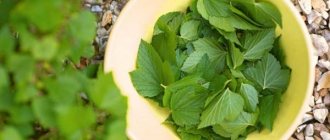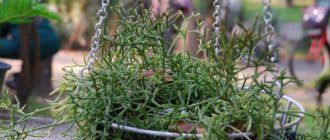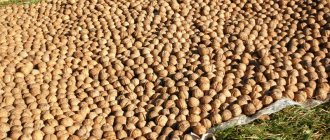When is the best time to collect rosehip, how to dry it and use it? What can you cook delicious, and most importantly healthy, with rose hips?
- When to collect?
- How to collect?
- How to dry?
- What is the best way to store rose hips?
- Recipes with dried rosehips Rosehip drink
- Rose hip jelly
- Vitamin tea made from rosehip, rowan and oregano
- Rose hip tea
- Rosehip compote
Time and months for drying for winter
When ready to pick, the berries should be bright orange or red, firm and healthy. Slightly unripe fruits contain more vitamin C, and those hanging longer on the branches contain more sugars.
When to harvest the plant depends on the region. The period usually lasts from the end of August until frost.
The weather during collection should be clear and dry.
Recipes with dried rose hips
The first thing to do with dried rose hips is to wash them. Then the fruits can be twisted in a meat grinder, cut with a knife or crushed on a plate with the bottom of a glass or cup if a small portion of raw materials is required. If you brew the rosehip whole, it will give less vitamins to the drink. As a rule, crushed fruits are poured with boiling water, boiled in a water bath for five to thirty minutes and infused in a thermos for about half an hour. You can not boil it, but pour boiling water over it and leave it in a thermos overnight. Usually, sugar, honey or herbs - mint, lemon balm or stevia - are added to rose hips to improve the taste before use. Before use, it is worth straining the infusion through cheesecloth so that the hairs do not irritate the digestive system.
Rosehip infusion can be drunk before meals 2-3 times a day for a month. In addition, it can be poured into ice cube trays and frozen: such cubes are an excellent cosmetic product that tones the skin.
Rose hip drink
Wash dried rosehips (1 tablespoon), crush them, pour boiling water (200 ml) and boil for 8-10 minutes. Place the broth in a warm place and then strain. You can add sugar or honey.
Rose hip jelly
Chop dried rose hips (100 g), add water (2 liters), boil over low heat for 15 minutes, then strain. Add sugar (200 g), lemon pieces or citric acid (0.5 g) to the broth, add starch (50 g) diluted in cold water, bring to a boil.
Vitamin tea made from rosehip, rowan and oregano
Add rose hips (20 g) and rowan (10 g) with water and cook for 5 minutes, add oregano herb (5 g), leave for 10 minutes.
Rose hip tea
Boil dried rose hips (100 g) in a liter of water for 5 minutes. Leave for 40-60 minutes, strain, add lemon juice and sugar to taste. Rose hips can be used not only dried, but also fresh.
dried rose hips
Instructions
- Rose hips are collected in dry, clear weather. The best time of day to collect is morning.
- You can pick berries by hand or use auxiliary tools for this: garden shears, a plastic bottle, a rake with a built-in bucket or a hoe.
- You should dress for collection in such a way that there are no exposed areas of your body. Clothing should be made of thick fabric, and hands should be protected with gloves.
- When hand-picked, the fruits are carefully picked along with the sepals and placed in a container.
- When using garden shears, they cut the berries into a substituted bucket, trying to preserve the stalk and not cut off the branches along with the fruit.
- At home they are sorted through, removing rotten and damaged ones, and laid to dry.
How to dry rose hips?
First, sort through the harvested crop and discard the affected fruits. No need to wash the berries! You can dry them either whole or cut into halves. The faster the drying, the less nutrients the rosehip will lose. If you plan to dry it in the oven, then preheat the oven to +40°C, hold a baking sheet with rose hips scattered in one layer in it for about an hour, then raise the temperature to +60°C. The rose hips will take 8-10 hours to dry. Second option: first hold the rose hips for 5-10 minutes at a temperature of 100°C, then dry at a temperature of +70...+75°C. For high-quality drying, constant air movement and moisture outflow from the oven are necessary. Convection ovens or an open door can provide the necessary conditions. Regular stirring or turning of the slices also contributes to uniform drying. If you plan to dry the fruits using a Russian oven, keep in mind that you can put rose hips in it two to three hours after it has been heated. You can also use a convection oven or electric dryer. When squeezed, the skin of a well-dried rosehip does not wrinkle, but springs back. Dried fruits crumble.
Rosehip tea is very beneficial
DIY harvester quickly
To make harvesting easier, you can make a harvester yourself.
- A piece of the required length is cut from a plastic sewer pipe with a diameter of 16 cm.
- Three deep slits of the required width are made at one edge.
- The blade from a construction knife is inserted horizontally into the lower part of the slots and tightly fixed with electrical tape. It will cut off the fruit.
- A plug is placed on the other end of the pipe.
Watch the video on how to make the device yourself:
Recipes with fresh rose hips
Rosehip compote
Wash the mature rose hips, cut them, remove seeds and hairs, rinse in cold water, dip in hot sugar syrup (0.5 kg of sugar per 1 liter of water) and leave in it for 8-11 hours. Then separate the fruits from the syrup and transfer to glass jars. Heat the syrup to a boil, boil for 2-3 minutes and pour the fruits into the jars. Then pasteurize in boiling water: half-liter jars - 10-15 minutes, liter jars - 15-20 minutes, then roll up the jars, turn them over onto the lid and leave until they cool.
Rosehip compote with sea buckthorn
A very pleasant and unusual compote can be prepared from large rose hips with sea buckthorn. Cut thoroughly washed rose hips in half, remove seeds and “hairs” (it’s more convenient to use a coffee spoon) and fill half-liter jars with them, alternating layers with sea buckthorn (in the ratio of 3 parts rose hips: 1 part sea buckthorn). Pour boiling sugar syrup (500 g of sugar per 1 liter of water), roll it up, turn it upside down, place it on the floor on a newspaper and wrap it in a warm blanket (or a jacket) overnight.
Rosehip and apple juice
Cut peeled rose hips (3-4 tablespoons) and apples (4-5 pieces) into small pieces, add cold water (1 liter) and boil for several minutes. Then strain, add sugar or honey (3-4 tablespoons), a little lemon or orange zest, lemon juice or citric acid (to taste) to the broth.
Punch with rose hips and red wine
Pour rose hips (50 g) with water (700 ml) and leave for several hours, then heat and boil for 3-5 minutes, then strain. Add 80-100 g of sugar and 0.5 liters of dry red wine to the filtrate, heat again, but not to a boil, and finally add the juice of 1 or 2 oranges. Serve hot.
Drink made from fresh rose hips
Pour washed fruits (500 g) into 2 liters of hot boiled water. When the water has cooled, add raisins (50 g) and syrup (500 g sugar per 500 ml water). Then cover the vessel and put it in a cool place. Drink the drink every 2-3 days.
Rosehip pureed with sugar
Mix rosehip puree with sugar in a 1:1 ratio, heat to a temperature of 70-80°C and immediately pack into hot sterilized jars and pasteurize in boiling water: half-liter - 20 minutes, liter - 25 minutes.
Rose hip jelly
Pour water (600 ml) over the seeds and hairs of rose hips (1 kg), boil over low heat until softened, wipe, squeeze out the juice. Dissolve sugar (500 g) in juice and cook until it reaches the consistency of jelly.
Rose hip puree
Peel ripe rose hips (1 kg) from seeds and hairs, rinse thoroughly, add water, boil for 10 minutes, place in a sieve. When the water has drained, wipe, add sugar (200 g), bring to a boil, pour in rosehip petal syrup (200 ml), stir. Pour the puree into sterilized jars, cover with lids, pasteurize at 70°C: half-liter jars - 15 minutes, liter jars - 20 minutes.
Rosehip jam
Select slightly unripe fruits of high-vitamin rosehip varieties. Wash, cut, remove hairs and seeds, blanch in boiling water (no more than 2 minutes), drain the water. Transfer the fruits to hot 70% sugar syrup, leave in it for 3-4 hours, then finish cooking the jam. It is advisable to prepare the syrup using water in which rose hips have been blanched. For 1 kg of prepared fruit, use 1.2-1.3 kg of sugar.
Rosehip jam with cranberries
Prepare rose hips (1 kg), add cranberries (300 g), sugar (1.2-1.5 kg per 1 kg of mixture). Cook like rosehip jam.
Selection of raw materials
There are many wild and cultivated varieties of this shrub.
There are decorative flowering species, which are considered less useful, and berry species, which have nutritional value and healing properties. As of 2022, 36 berry varieties are officially registered in the State Register of the Russian Federation.
It is customary to harvest rose hips, but all parts of the plant are traditionally used for medicinal purposes: leaves, flowers, twigs and even roots . The fruits, depending on the species, have a round, flattened, elongated shape. Their color is also varied: from orange and reddish-scarlet to brownish and almost black. Size in this case does not matter.
According to their structure, berries are conventionally divided into three categories: thin-walled, thick-walled, fleshy, of which it is preferable to choose the first two groups for drying. Fleshy fruits are best dried or eaten raw.
Berries of different varieties differ from each other in shape, color, size, wall thickness
Medical studies show that the pulp contains many sugars, inorganic acids, pectins, tannins, and flavonoids. It is rich in vitamins (C, P, K, B2, A) and microelements (zinc, iron, manganese, etc.). For collecting and preparing, it is, of course, better to choose varieties with the highest content of vitamin C. Experts advise determining the usefulness of fruits by the location of the sepals: if their tips stick out straight, closing with each other, it means that the berries contain a lot of antioxidants and other biologically active elements.
The data obtained by specialists in laboratory conditions is presented in the table:
| Variety name | Content of ascorbic acid in fresh fruits (mg/%) |
| "Vitamin VNIVI" | 3200-4200 |
| "Russian 1" | 3300 |
| "Ruby" | 3253 |
| "Vorontsovsky 3" | 3200 |
| "Globe" | 2390 |
| "Titanium" | 2030 |
| "Apple" | 1400 |
| "Hedgehog" | 1261,1 |
| "Rukh" | 1020 |
| "Michurinsky Yubileiny" | 869,8 |
| "Scarlet" | 850 |
| "Geisha" | 806,4 |
| "Spire" | 520 |
Preparing for drying
The collected fruits are sorted out, and those spoiled by insects and diseases, unripe and overripe specimens are carefully discarded. Lightly rinse under running water to remove dust and allow excess moisture to drain, then blot with a paper towel, changing it several times.
Some housewives prefer to cut the fruits, clean the seeds, pinch off the sepals and stalks
Rosehip seeds contain substances that irritate the esophagus and can cause allergic reactions and even food intoxication. The labor-intensive and painstaking cleaning procedure takes a lot of time, but allows you to quickly dry the berry pulp and make the stock more convenient for further use.











